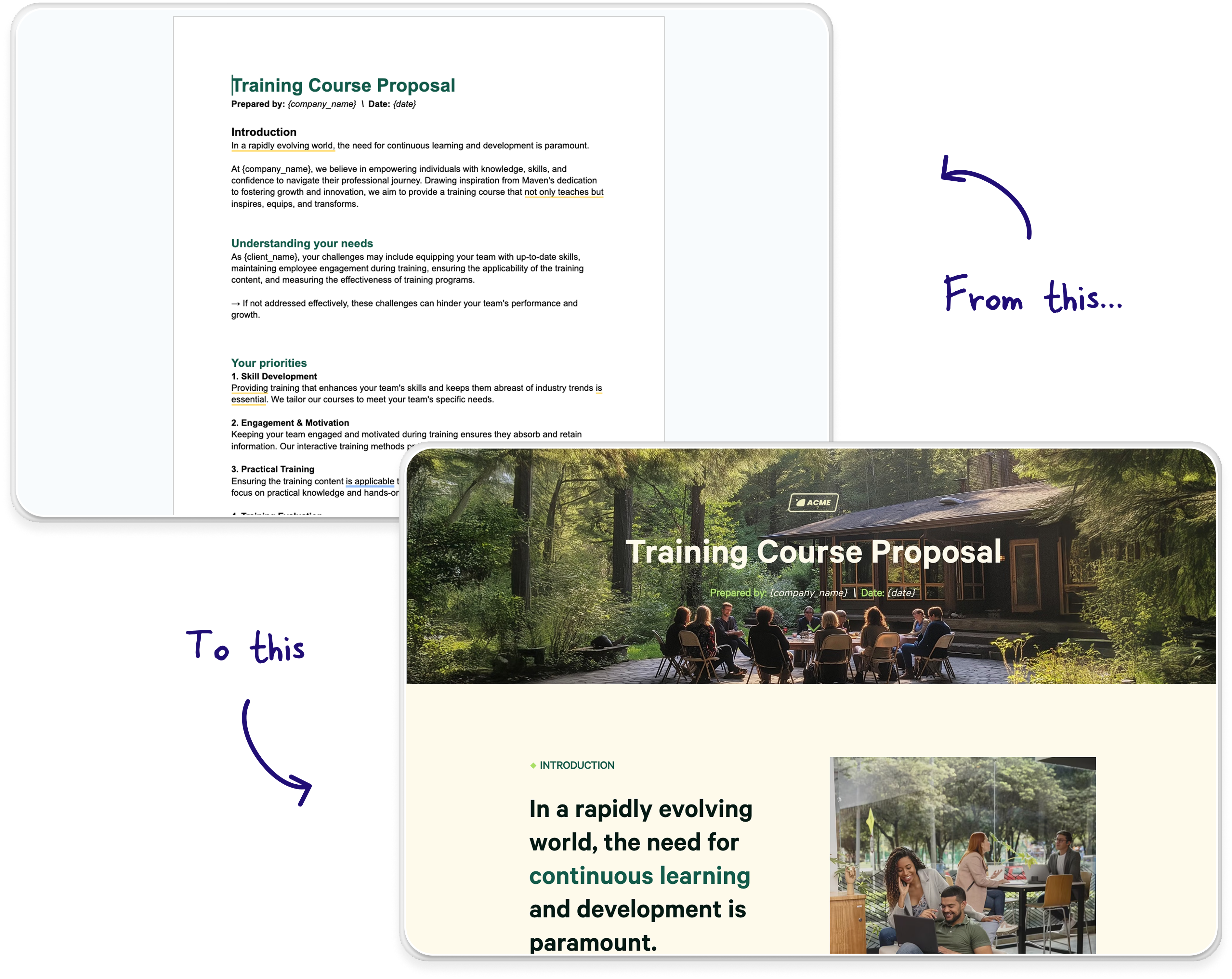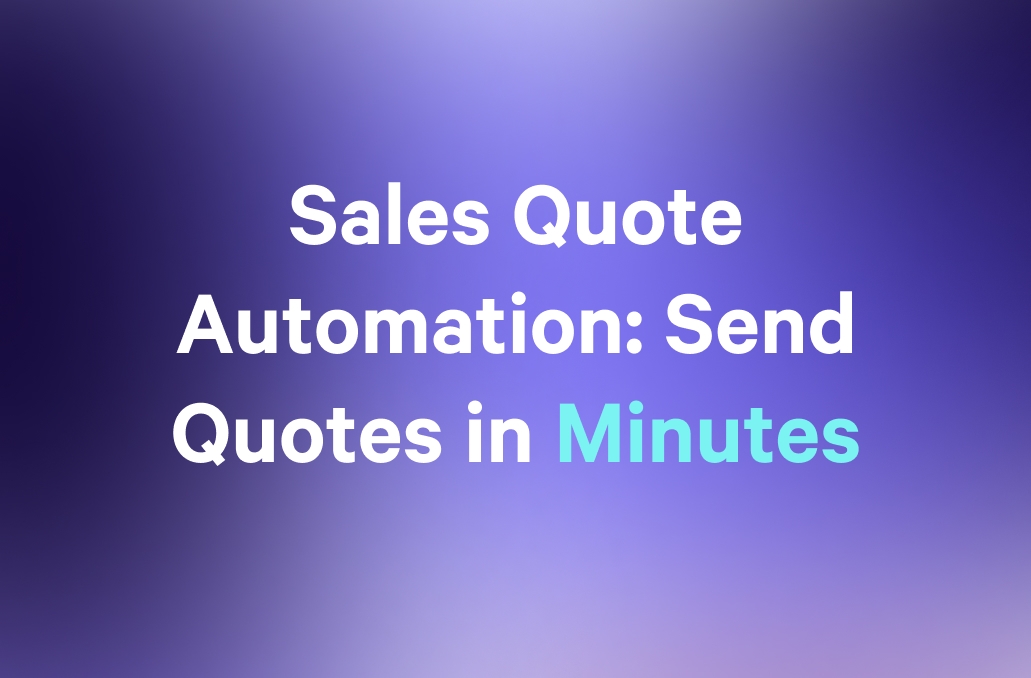In the traditional sales process, a proposal and an invoice live at opposite ends of the buyer journey. One paints the vision; the other collects the cash. But what if you could combine them: streamline the workflow, improve conversion rates, and get paid faster? With modern sales tools like QwilrPay, that’s not just possible, it’s becoming best practice.
Let’s break down the difference between proposals and invoices, explore why they’ve historically been separated, and explain how embedding payments into proposals using QwilrPay can radically simplify your sales process.
Key takeaways
- Proposals and invoices don’t need to be separate: Traditionally, proposals sell and invoices collect, but keeping them apart creates friction.
- Combining steps improves the buyer experience: Clients don’t want to bounce between PDFs, emails, and payment portals. QwilrPay allows them to view, approve, and pay - all in one place.
- Embedded payments boost results: According to Stripe, embedded payment options aren’t just convenient, they’re high-performing.
- QwilrPay simplifies and accelerates payments: Proposals, e-signatures, and payments all live in one platform. That means faster payments, less admin, and a more professional impression.
What’s the difference between a proposal and an invoice?
Basic but necessary, here it is.
What is a proposal?
A proposal is a persuasive document that outlines the scope of a project, pricing, timelines, deliverables, and terms. It’s meant to convince the client to say “yes.” Think of it as part pitch, part plan.
Sales teams and service providers use proposals to:
- Showcase expertise
- Define deliverables and timelines
- Present pricing options
- Outline terms and conditions
- Build trust with potential clients
At this stage, no money changes hands. A proposal is a promise of value, not a transaction.

What is an invoice?
An invoice, on the other hand, is a request for payment. It’s a financial document typically sent after work has been completed… or in some cases, before work begins, but after a deal has been agreed upon.
Invoices usually include:
- Invoice number
- Payment terms
- Detailed list of products/services
- Total amount due
- Due date
- Payment instructions or links
It’s purely transactional: no storytelling, no persuasion.
Why have proposals and invoices been kept separate?
Historically, proposals and invoices serve two very different functions:
Proposals sell. Invoices collect.
They’ve also been handled by different tools and teams. Proposals might be created by salespeople using slide decks, PDFs, or proposal software. Invoices are often generated by finance teams using accounting tools.
But here’s the problem: that separation creates friction.
Clients accept a proposal and then wait for a separate invoice. Sales teams spend time chasing down signatures, only to later chase down payments as well. Even when prospects say “yes,” payments often get delayed—or worse, forgotten. The gap between proposal and invoice is where deals say “bye-bye, see you never”.
Can you combine them?
Yes! And you would be smart to.
Combining proposals and invoices creates a more seamless, efficient, and conversion-friendly experience for both you and your clients.
Instead of dragging your client through multiple steps (proposal - approval - invoice - payment), you create a single, frictionless moment: accept and pay.
But how?
Introducing QwilrPay: Proposal + Payment in one step
QwilrPay is Qwilr’s new built-in payments feature that lets you collect payments directly within your proposals. It’s the future of selling where deals close faster, and money changes hands the moment a client says “yes.”
Let’s say you send a proposal for a $5,000 marketing project. With QwilrPay, your client can:
- Review the proposal
- Sign digitally
- Pay instantly - via credit card, ACH in the US, BECs in Australia, and more
No waiting for an invoice. No bouncing between tools. No awkward “did you get the invoice I sent?” follow-ups.
Powered by Stripe, once your customer has made a payment, an invoice will automatically be generated.

Why combine proposals and payments?
Here are some compelling reasons to blur the line between proposal and invoice:
1. Close deals faster
Every step you remove from the sales process increases your chances of closing. When a client accepts your proposal, they’re at peak interest. Strike while the iron’s hot, AKA before procurement bottlenecks or other priorities get in the way.
QwilrPay eliminates the lag time between proposal acceptance and payment. It’s one less email, one less document, one less delay.
2. Improve cash flow
For service businesses, cash flow is often tied up in slow payment cycles. You deliver great work, but you’re always waiting for the next payment to drop.
With QwilrPay, you can require payment upfront or partial payment at proposal acceptance. That means:
- Fewer outstanding receivables
- Less admin chasing overdue invoices
- More predictable revenue
And with support for recurring payments via Stripe integration, QwilrPay even helps you transition clients onto retainer models more easily.
3. Reduce tool sprawl
Why use a proposal tool and an invoicing tool, and a payment processor if you can combine them?
Qwilr consolidates your tech stack, giving your sales team one platform to:
- Create beautiful, interactive proposals
- Track views and engagement
- Capture e-signatures
- Collect payments
No more hopping between platforms. Everything happens in one place, from pitch to payment.
4. Create a better client experience
Clients are busy. They don’t want to wade through multiple documents or chase down payment links. A streamlined experience shows that you’re professional, modern, and efficient.
With QwilrPay, clients experience:
- One unified, branded document
- A seamless review - approve - pay flow
- Multiple payment options
It’s like a one-click checkout, but for services.

Who should combine proposals and payments?
Spoiler, but also not really: This isn’t just for tech startups or digital agencies. The proposal-plus-payment model works for any business that offers project-based or retainer services, sells fixed-price packages, or simply wants to reduce friction in the buying process.
It’s particularly well-suited to marketing and design agencies, software development firms, consulting practices, event planners, freelancers, and SaaS companies with professional services arms. These businesses often juggle multiple proposals, clients, and timelines, making a streamlined payment process not just helpful, but essential.
If you’re still manually sending proposals, waiting for a reply, and then generating an invoice in a separate tool, it’s time to rethink your process.
Common objections (and how to overcome them)
“We need to send formal invoices for accounting.”You still can! QwilrPay doesn’t replace your accounting software. It just streamlines the client-side experience. You’ll still have a record of all transactions in the payment dashboard, and you can export payment data for bookkeeping.
“Not all our clients want to pay upfront.”That’s fine. QwilrPay is flexible. You can set payment to be optional, partial, or required. You can even allow offline payment options for clients who prefer wire transfers or checks.
Proposal + invoice = A modern sales motion
In the past, proposals and invoices were kept apart because of process limitations, not because it was the best way to sell. With digital tools, we’re no longer bound by those constraints.
By combining proposal, acceptance, and payment into a single flow, you can increase close rates, accelerate cash flow, simplify operations, and delight your clients. The future of sales is frictionless, and it starts by rethinking the moment a deal is won.
The numbers don’t lie: embed payments for better results
Stripe tested the conversion impact of global payment methods. And here’s what they found: Integrating payments within proposals isn’t just a nice-to-have; it’s a conversion and cash flow booster.
1. +7.4 % Conversion Lift
When businesses dynamically display at least one extra payment method beyond credit cards (such as local payment options, digital wallets, or bank debits), they see an average 7.4 % increase in conversion rates.
2. +12 % Revenue uplift
These same businesses experience a 12 % boost in revenue when offering that additional payment method.
As the old saying goes… the proof is in the pudding…
Ready to combine proposals and payments?
If you’re tired of chasing signatures, sending invoices, and waiting weeks to get paid, it’s time to try a new approach.
All in one platform. No more silos. No more delays.
Try Qwilr today and turn your next “yes” into “yes, and paid.” And if you’re curious about the other gems that Qwilr pulls out of their sales bag, sign up for a free trial to streamline your proposal process.
About the author

Brendan Connaughton|Head of Growth Marketing
Brendan heads up growth marketing and demand generation at Qwilr, overseeing performance marketing, SEO, and lifecycle initiatives. Brendan has been instrumental in developing go-to-market functions for a number of high-growth startups and challenger brands.


